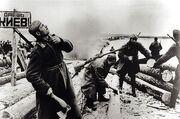| |||||||||||||||||||||||||||||||||||||||||||
The Ukrainian State (Ukrainian: Українська держава, Ukrayinska Derzhava), commonly referred to as Ukraine or The Hetmanate, was satellite state of the Central Powers created in the final months of the First World War from 1918 until it was overrun by the Red Army in 1939, the event which sparked World War II.
Although Ukraine was officially a independent state, not fully recognized internationally, its foreign affairs were tightly controlled by Berlin. Geographically, the Ukrainian State was situated in Eastern Europe to the north of the Black Sea, bordered by Romania, Belarus, the Soviet Union, Austria, and Poland. Following the First Battle of Kiev the Ukrainian government fled to Austria but despite pleas from Hetman Pavlo the hetmanate was never restored following World War II.
History[]
Founding: 1917–1918[]
After the Russian Revolution of 1917, several factions sought to create an independent Ukrainian state, alternately cooperating and struggling against each other. Numerous more or less socialist-oriented factions participated in the formation of the Ukrainian National Republic (UNR) among which were Bolsheviks, Mensheviks, Socialists-Revolutionaries, and many others. The most popular faction was initially the local Socialist-Revolutionary that composed the local government together with Federalists and Mensheviks. The Bolsheviks boycotted any government initiatives most of the time, instigating several armed riots in order to establish the Soviet power without any intent for consensus.
Immediately after the October Revolution in Petrograd, Bolsheviks instigated the Kiev Bolshevik Uprising to support the Revolution and secure Kiev. Due to a lack of adequate support from the local population and anti-revolutionary Central Rada, however, the Kiev Bolshevik group split. Most moved to Kharkiv and received the support of the eastern Ukrainian cities and industrial centers. Later, this move was regarded as a mistake by some of the People's Commissars (Yevgenia Bosch). They issued an ultimatum to the Central Rada on December 17 to recognise the Soviet regime of which the Rada was very critical. The Bolsheviks convened a separate congress and declared the first Soviet Republic of Ukraine on December 24, 1917 claiming the Central Rada and its supporters outlaws that need to be eradicated. Warfare ensued against the Ukrainian National Republic (UNR) for the installation of the Soviet regime in the country and with the direct support from Soviet Russia the Ukrainian National forces were practically overran.
On February 9, 1918 Ukraine signed the Treaty of Brest-Litovsk with the coalition of Central Powers and in March 1918 all Bolshevik forces of the Russian SFSR were eliminated from the territory of Ukraine. The Army Group "Kiev" was created in order to protect Ukraine from further Bolshevik aggression and headed by the German Field Marshall Hermann von Eichhorn. After the Treaty of Brest-Litovsk, the Russian SFSR yielded all the captured Ukrainian territory as the Bolsheviks were forced out of Ukraine. The government of the Soviet Ukraine was dissolved after its last session on November 20, 1918. April 29, 1918 a party congress of bread producers consisting of some 6,000 delegates from all eight guberniyas of Ukraine was taking place in the building of the Kiev Circus. Pavlo Skoropadskyi after receiving information about the situation at the congress from his couriers later arrived in his car to the event where he was elected the Hetman of Ukraine.
Interwar years: 1922–1939[]

Soviet soldiers preparing rafts to cross the Dnieper during the Battle of the Dnieper (1943). The sign reads "Give me Kiev!".
In 1932, the aggressive industrial policies of the Ukrainian government resulted in one of the largest national catastrophes in the modern history of the Ukrainian nation. A man-made famine known as the Holodomor caused a direct loss of human life estimated between 2.6 million. Some scholars have claimed that this was an act of genocide, while other scholars assert that the catastrophe was caused by gross mismanagement and failure to industrialize on a voluntary basis.





